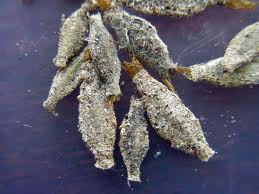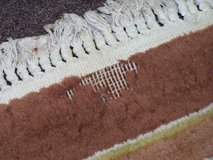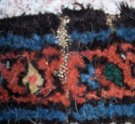Moths
The Clothes Moth Has NOT
Been Eliminated!
In past years, textile-eating moths were common due to the large amount of wool fibers in clothing and home furnishings. The popularity and widespread use of synthetic fibers has led to the incorrect assumption that damage from these insects is a thing of the past.
Clothes moths can digest protein fibers such as wool, silk, and specialty hair fibers, but these insects will also find and eat protein substances on synthetic fibers. This means carpets, rugs, draperies, and upholstery made from nylon, acrylic, polyester, acetate, and other synthetics can harbor these insects if they contain food or beverage stains, blood, urine, perspiration or other sources of nutritional protein.
How to Prevent Moths?
The most effective way to prevent an infestation of moths and inhibit growth is to keep textile furnishings clean. Spills should be removed as soon as possible. Carpet, rugs, draperies, upholstery, etc., should be brushed or vacuumed regularly as insects do not generally attack clean materials.
Regular dry cleaning of articles appropriate for dry cleaning will also decrease the chances of infestation because dry cleaning solvent is toxic to most textile pests. Regular carpet and rug cleaning will remove the nutritional contaminants that can attract and support insects.
MOTHS - What are They?
There are 2 different types of these moth pests that we need to be concerned about. Both are types of clothes moths, the insect that eats our textiles.
The Webbing Moth (Tineola bisselliella). The adult moths of this species are about a half inch long and yellowish beige in color.
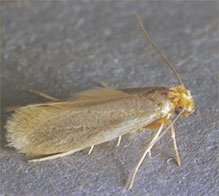
The Casemaking Moth (Tinea pellionella). Casemaking moths are similar in size but are brownish and have three dark spots on their forward wings.
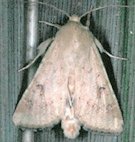
The Larvae of the Moths
Cause the Damage
The adult moths themselves cause no damage, but the larvae (the wormlike active immature form of the insect) they produce are very damaging. It is the larvae that actually feed on wool.
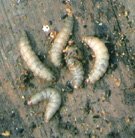
Each larva spins a silken tube that acts like a barrier of protection. The webbing moth larvae attach their tubes to dark crevices or seams, rendering themselves stationary to feed in one location. The casemaking moth larvae do not attach their tubes or 'cases' which allows them to remain mobile and cause a wider spectrum of damage.
Life Cycle of Moths
The life cycle of moths can last from two months to two and a half years. The adults lay eggs on products that the larvae will consume.
Each female can lay from 100 to 150 eggs, which hatch in about five days. The small white caterpillar larvae vary in size from 1/16 inch newly hatched to 1/3 inch fully grown.
The larval stage itself can last from 2-30 months. The great variance in the life cycle is due to the presence or absence of food. That is why these creatures can be so devastating to rugs. Rugs provide a huge source of food. If gone unnoticed, the larvae can feed for almost two and a half years! An infestation of only several weeks can result in pile loss the size of a fist.
Where to Find Moths
Clothes moths thrive in dark, undisturbed areas where a rug gets little traffic and is not often vacuumed. They are particularly attracted to the keratin in animal hair. The wool alone in an oriental rug is susceptible, but just imagine a dirty rug covered in dog and cat hair. That would be like a smorgasbord to this creature!
Moths can feed on mixtures of natural and synthetic fabrics. However, they cannot feed on materials made solely of synthetic fibers. As mentioned above, they can be found in synthetic fibers which have pollen, hair, dead insects, and dried animal remains on them.
How Do You Know If You are Harboring Moths?
- The actual flying adults. When a lot of flying adults are present the infestation can be considerable.
- Loose carpet fibers resting on top of the pile. This results from the larvae actually eating the knots off the foundation of the rug.
- Cocoons—1/8 inch diameter x one-half inch long. They will be slightly fuzzy cylinders, usually the same color as the rug’s pile. (Larvae camouflage their cocoons to blend in with the color of the wool that surrounds them).
- The actual larvae squirming along the pile surface and underneath the rug.
An interesting fact about clothes moths is that unlike other varieties, they are not attracted to bright lights and tend to seek darker areas or dim light. This makes it very difficult to detect them in dark closets and drawers. It is most likely that you will notice fabric damage or larvae before you see the moths themselves.
How Do We Get Rid of Moths?
When it comes to getting rid of these creatures, controversy ensues. Different books have cited everything from placing an infested rug in the sun for a few hours to rolling them up and placing them in a cavernous freezer. The infestation must be dealt with quickly and a solution to the problem must be found that is as effective as possible.
A thorough professional rug cleaning is the best way to prevent damage because the washing removes the larvae and the hot drying destroys the eggs.
This is good to know but it doesn’t address the possibility that larvae may move from one rug to another. What this means is that it is necessary to find and kill not only the adults but their larvae and their eggs even before the infected rug is cleaned. A call to a licensed pest control operator may be required if the infestation is severe.
Pyrethrum--The Most Effective Insecticide
The most effective and safe insecticide that can be used is pyrethrum. It is the oleoresin extract of dried chrysanthemum flowers. The extract contains about 50% active insecticidal ingredients known as pyrethrins. These strongly lipophilic esters rapidly penetrate many insects and paralyze their nervous systems.
Both crude pyrethrum extract and purified pyrethrins are contained in various commercial products, commonly dissolved in petroleum distillates. Some are packaged in pressurized containers (bug-bombs), usually in combination with synergists. The synergists retard enzymatic degradation of pyrethrins.
Some commercial products also contain organophosphate or carbamate insecticides. These are included because the rapid paralytic effect of pyrethrins on insects (quick knockdown) is not always lethal.
Are Pyrethrins Safe?
Pyrethrins are commonly found in pet shampoos, so that should tell us that it is relatively safe.
Will pyrethrins cause dyes to become unstable? The research does not support this. Pyrethrins break down quickly after application and are considered safe for use in the home.
Please remember, as with any product used in the home, it is important to read the label and test it in an inconspicuous area.
Moth Balls, Flakes and Crystals?
Be aware that these compounds (paradicholorobenzene or naphthalene) are ineffective in control of these insects for rugs. (Cedar scent is also useless.)
These materials act only as a minor repellent. They do not kill the larvae or eggs, and the naphthalene odor can be unpleasant and extremely difficult to remove.
Of most importance, paradichlorobenzene may be a carcinogen and may also damage the liver and kidneys at high doses. Naphthalene can damage the liver and cause eye injury.
Mothballs can be especially dangerous if accidentally eaten, especially by young children. In general, it is recommended that they should not be used by homeowners under any circumstances. If they continue to be used, they should only be used in small amounts and items around them should be thoroughly cleaned.
Mothball ingredients can produce harmful effects when they enter your system through inhalation. Irritation to nose, throat and lungs, headache, confusion, excitement or depression and liver and kidney damage can result from exposure to the vapors over a long period of time.
The little white balls that contain naphthalene are of special concern because naphthalene can promote a breakdown of red blood cells resulting in hemolytic anemia. Hemolytic anemia in mild form may cause only fatigue. In more severe cases, it can cause acute kidney failure.
Of course, only high concentrations of these ingredients can cause any of these effects. Such concentrations are found when vapors are absorbed by clothes or rugs that are stored or kept in closed areas with poor ventilation.
Poisonings have been reported following dressing of infants in clothing that was stored with naphthalene mothballs, suggesting that absorption of naphthalene may occur through the skin.
Moth balls should be taken to a licensed hazardous waste handler to be disposed of or saved for a professional household hazardous waste collection program.
Prevention of Infestations
One of the major hurdles in preventing damage from moths is consumer education. People are home less often (post-COVID) than ever before. They have less time to care for their rugs and carpets (for example, vacuuming) and even less to inspect dark places such as under furniture, etc. Rugs, carpets, wool clothing, and wall hangings get dirty and they are just lying and hanging targets.
It is especially important, when preparing rugs for long term storage (6 months to several years), that they be kept safe from infestation. Never attempt to store a dirty rug.
At ABC, our cleaning of wool rugs includes a final rinse which renders the wool unappetizing to these creatures. This 'retardant' feature combined with a thoroughly cleaned rug will almost completely guarantee prevention of damage during storage.
The Best Way to Protect Against Moths
The best way to prevent an moth infestation is periodic inspection of rugs, whether stored or not, as well as the carpets and wool, silk, and cotton textiles in your home.
Be sure to check underneath furniture and behind wall hangings as well. At the first sign of a problem, please call or text our office at 607-272-1566 if you have any questions. We are prepared to help you in any way we can.
Please click here for our Pick Up and Delivery Policy and our Pick Up and Delivery Service Areas.
For other textile insects, please click here. For special treatment for your oriental and area rugs, please click here.
If you do not live in our service area, please feel free to call or text our office at 607-272-1566 or send us your rugs by mail or through a delivery service such as Fed Ex or UPS.
Back to Articles
Back to Homepage
"The Cleanest Clean You've Ever Seen."
by
ABC Oriental Rug & Carpet Cleaning Co.
130 Cecil Malone Drive Ithaca, NY 14850
607-272-1566
